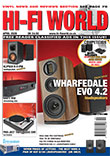Leema Tucana Vs Stello Ai500 - Measured Performance |
Page 4 of 4
MEASURED PERFORMANCE The Tucana II delivers 162 Watts into 8 Ohms, measurement shows, rising to 272 Watts into 4 Ohms, very high levels of power. Leema warn it has no output protection circuits so a short will cause damage. The advantage of this, they suggest, is that current limiting does not exist to degrade sound quality. With a high damping factor of 74 the Tucana II will exert strong electrical damping and help tighten up loudspeakers that are acoustically under-damped and waffly. Bandwidth was wide, stretching from 3Hz to 102kHz, the upper limit matching that of 192kHz sample rate sources. Input sensitivity measured a normal 300mV through both the normal phono socket CD input (unbalanced) and the balanced XLR CD inputs. Measured performance through XLR was similar to that via the phono sockets Distortion levels were low right across the audio band, measuring just 0.001% at 1kHz and 0.005% at 10kHz, both at 1 Watt. Our analysis shows a progressively reducing harmonic structure with second harmonic dominant and this pattern was maintained as power increased, so the Tucana II has a dynamically stable transfer characteristic and should sound easy on the ear as a result. The Tucana II is a high power amplifier that measures well all round. It should provide fine sound quality. NK Power 162 Watts CD/tuner/aux. Frequency response 3Hz-102kHz Separation 82dB Noise -91dB Distortion 0.005% Sensitivity 300mV DISTORTION - TUCANA II
MEASURED PERFORMANCE The Stello Ai500 delivers 153 Watts into 8 Ohms under measurement, rising to 240 Watts into 4 Ohms, so there is no shortage of power. The Ai500 has an unusually high damping factor of 126 so it will exert very strong electrical damping and will sound ‘tight’ in its bass quality, especially with loudspeakers that are acoustically under-damped and boomy, where it will apply useful control. Distortion levels were very low right across the audio band, measuring just 0.002% at 1kHz and 0.006% at 10kHz, both at 1 Watt. Our analysis shows second harmonic dominates and this was the case right across the audio band, at all power outputs. The Ai500 has certainly been carefully engineered to achieve this unusual property and it does make for an easy and natural sound. Measuring 320mV in for full output, the balanced XLR socket CD inputs have half the input sensitivity of the normal phono sockets, but both figures are good. Measured performance was otherwise similar through both inputs. Bandwidth was wide but limited all the same, stretching from 10Hz to 68kHz The S/PDIF digital inputs, optical and electrical, have a pronounced high frequency roll off, measuring -1dB at 17kHz with 44.1 and 48kHz sample rates. This will slightly smooth the sound from digital sources; it isn’t enough to make them sound dull or warm however. Linearity was good, distortion at 0dB measuring 0.002%, and at -60dB a normal 0.22% with 16bit and 0.08% with 24bit digital code, both results being as good as it gets, so the Ai500 has linear D/A convertors. The Ai500 is a very carefully engineered amplifier that is likely to have very good sound quality. NK Power 153 Watts CD/tuner/aux. Frequency response 10Hz-68kHz Separation 85dB Noise -90dB Distortion 0.006% Sensitivity 160mV DISTORTION - STELLO Ai500
|








